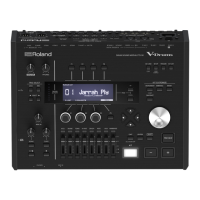45
Settings
Assigning Functions to Foot Switches or Pads
(CONTROL)
Foot switches (BOSS FS-5U, FS-6; sold separately) or pads that are
connected to the TD-50 can be assigned to control functions such
as switching drum kits or switching set lists.
Reference
For details on the parameters that can be edited, refer to “Data
List” (PDF).
Assigning a function to a footswitch
Connecting an FS-5U
SW 2SW 1
TIP
Stereo 1/4” phone type
1/4” phone type x 2
RING
POLARITY switch
* If you use a mono cable to connect a single FS-5U, it will operate
as SW 2.
* The FS-5L cannot be used.
Connecting an FS-6
Stereo 1/4” phone type
Stereo 1/4” phone type
SW 2
SW 1
MODE/POLARITY switch
1. In the SETUP MENU 1 screen (p. 42), press the [F4]
(CONTROL) button.
2. Press the [F1] (FOOT SW) button.
The FOOT SWITCH CONTROL screen appears.
3. Use cursor buttons to select a parameter, and use the [–]
[+] buttons or the dial to edit the value.
MEMO
If you want to use a footswitch to switch drum kits in a set list
(p. 33), assign the function of the footswitch to “KIT# DEC” or
“KIT# INC,” and press the [SET LIST] button to make it light.
(Create a set list beforehand.)
4. Press the [KIT] button to return to the DRUM KIT screen.
Assigning functions to pads
You can assign a function to a pad that’s connected to TRIGGER
IN jack 13/AUX3 or 14/AUX4, or to a pad that supports digital
connection and is assigned to AUX3/4.
1. In the SETUP MENU 1 screen (p. 42), press the [F4]
(CONTROL) button.
2. Press the [F2] (PAD CTRL) button.
The PAD SWITCH CONTROL screen appears.
3. Use cursor buttons to select a parameter, and use the [–]
[+] buttons or the dial to edit the value.
MEMO
5 If you don’t want sound to be heard when you strike the pad,
use MIXER VOLUME (p. 22) to set the AUX3 and AUX4 volume
setting to “0.” Alternatively, press the [INSTRUMENT] button
and select “OFF” as the instrument for AUX3 and AUX4 (p. 19).
5 If you want to use a pad to switch drum kits in a set list
(p. 33), assign the function of the pad to “KIT# DEC” or “KIT#
INC,” and press the [SET LIST] button to make it light. (Create
a set list beforehand.)
4. Press the [KIT] button to return to the DRUM KIT screen.
MIDI Settings (MIDI)
Here you can make MIDI settings for the entire TD-50.
Reference
For details on the parameters that can be edited, refer to “Data
List” (PDF).
1. In the SETUP MENU 2 screen (p. 42), press the [F1] (MIDI)
button.
The MIDI screen appears.
2. Press a [F1] (BASIC)–[F4] (PROG CHG) button to select the
item that you want to edit.
Button Explanation
[F1] (BASIC) button
Makes basic MIDI settings such as specifying the
channel on which the TD-50 transmits and receives
MIDI data.
[F2] (CONTROL) button
Species the MIDI messages that are transmitted
or received to indicate the pad striking location or
the position of the hi-hat pedal.
[F3] (SYNC) button Species settings related to MIDI synchronization.
[F4] (PROG CHG)
button
Lets you freely specify the correspondence
between drum kits and the program changes that
are transmitted and received.
3. Use cursor buttons to select a parameter, and use the [–]
[+] buttons or the dial to edit the value.
4. Press the [KIT] button to return to the DRUM KIT screen.

